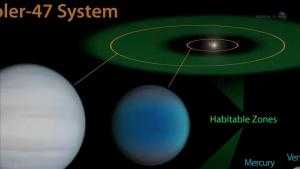Kepler-47

Kepler-47 is a binary star system with at least three planets in orbit around the pair of stars located about 5,000 light-years away from Earth.[1] The first two planets announced are designated Kepler-47b, and Kepler-47c. Kepler-47 is the first circumbinary multi-planet system discovered by the Kepler mission.[2] The outermost of the planets is a gas giant orbiting within the habitable zone of the stars.[3] Because most stars are binary,[4] the discovery that multi-planet systems can form in such a system impacts theories of planetary formation.
A group of scientists from NASA and Tel-Aviv University in Israel discovered the system via NASA's Kepler space observatory in 2012.[5] In November 2013, confirmation of a third planet was announced.[6]
Kepler-47b
Kepler-47b is a gas giant and resides close to its parent stars and therefore is inhospitable to life. It is thought to be larger than Kepler-47c and is roughly three times the radius of Earth.[2] At present it is unknown if this planet has any moons.
Kepler-47c
This planet is situated within the habitable zone and its radius is 4 times the Earth's. Although it is assumed Kepler-47c is not capable of harbouring life.[7] Kepler-47c is marginally larger than Neptune and could possibly have a dense atmosphere.[8]
See also
| Wikimedia Commons has media related to Kepler-47. |
- NN Serpentis, a binary star announced to have two planets in 2010
- List of extrasolar planet firsts
References
- ↑ "BBC News - Tatooine-like double-star systems can host planets". Bbc.co.uk. 2012-08-29. Retrieved 2012-11-04.
- ↑ 2.0 2.1 "NASA's Kepler Discovers Multiple Planets Orbiting a Pair of Stars". NASA. 2012-08-28. Retrieved 2 September 2012.
Kepler mission has discovered multiple transiting planets orbiting two suns for the first time
- ↑ "NASA's Kepler discovers multiple planets orbiting a pair of stars". Sciencedaily.com. 2012-08-28. doi:10.1126/science.1228380. Retrieved 2012-11-04.
- ↑ Quintana, Elisa, V. et al. (November 2006), "Terrestrial planet formation surrounding close binary stars", Icarus 185 (1): 1–20, arXiv:astro-ph/0607222, Bibcode:2006Icar..185....1Q, doi:10.1016/j.icarus.2006.06.016
- ↑ Shamah, David (30 August 2012). "New worlds discovered, courtesy of US-Israel team". The Times of Israel. Retrieved 30 August 2012.
- ↑ http://nexsci.caltech.edu/conferences/KeplerII/agenda.shtml
- ↑ "Tatooine-like double-star systems can host planets".
- ↑ "Two planets ... Two stars: Nasa detects strange new solar system (and one of the planets occupies the life-supporting 'Goldilocks zone')". Daily Mail (dailymail.co.uk). 30 August 2012.
Coordinates: ![]() 19h 41m 11.5s, +46° 55′ 12″
19h 41m 11.5s, +46° 55′ 12″
| ||||||||||||||||||||||||||||||||||||||||||||||||||||||||||||||||||||||||||||||||||||||||||